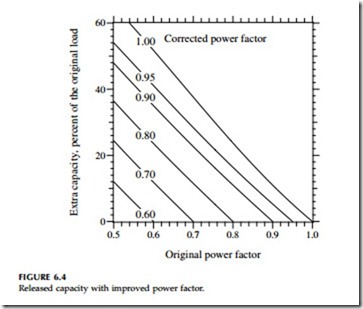Released Capacity
In addition to reducing losses and improving voltage, capacitors release capacity. Improving the power factor increases the amount of real-power load the circuit can supply. Using capacitors to supply reactive power reduces the amount of current in the line, so a line of a given ampacity can
carry more load. Figure 6.4 shows that capacitors release significant capacity, especially if the original power factor is low. Figure 6.5 shows another way to view the extra capacity, as a function of the size of capacitor added.
Related posts:
PISTON ENGINE–BASED POWER PLANTS:DUAL-FUEL ENGINES
Transformers:Substation Transformers
Summary of Stress Analysis of 3L-NPC Wind Power Converter Under Fault Condition
Medium-Voltage Switchgear and Circuit Breakers:AC Methods of Tripping and Circuit Breaker Closing
Electrical Power System Grounding and Ground Resistance Measurements:Ground Grid Integrity Measureme...
Greener diesels:Dual-fuel engines
General Overview:Investment in Energy Infrastructure
Semiconductors:ESD Failure Modes
Grounding Tower Elements:Grounding on Bare Rock and Rock-Based Radial Elements.
The Current Situation and Perspectives on the Use of Hydropower for Electricity Generation:Romania
The Current Situation and Perspectives on the Use of Wind Energy for Electricity Generation:Spain
The Current Situation and Perspectives on the Use of Nuclear Energy for Electricity Generation:Main ...
Electricity and potentially explosive atmospheres:Equipment installation
Motors and Generators
Basic troubleshooting:Air inlet system
